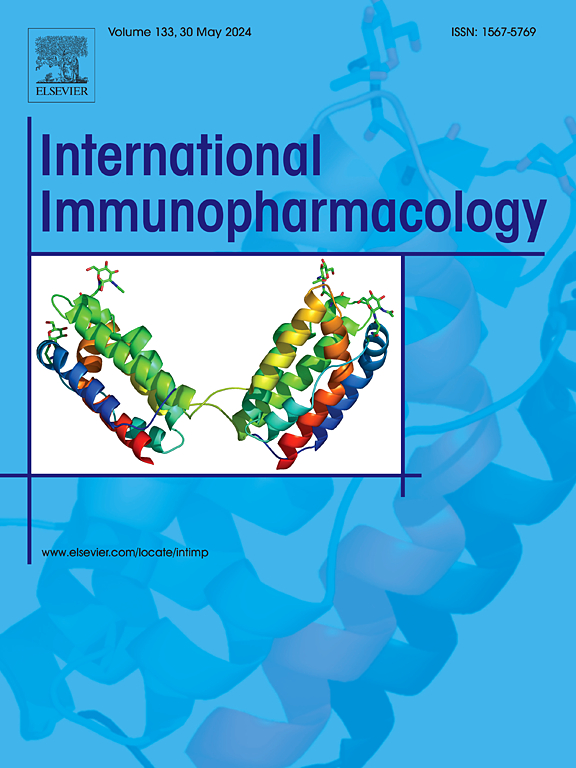SLC7A11 suppresses pyroptosis to alleviate rheumatoid arthritis development by modulating the IL-17 pathway
IF 4.8
2区 医学
Q2 IMMUNOLOGY
引用次数: 0
Abstract
Background
Rheumatoid arthritis (RA) is an autoimmune disease of unknown etiology. This study aims to explore the potential mechanisms by which solute carrier family 7 member 11 (SLC7A11) influences RA development.
Methods
Collagen-induced arthritis (CIA) mice were constructed to observe disease onset and pathological scores. Pathological changes were examined using Hematoxylin-eosin and Safranin O-Fast Green staining. Levels of lactate dehydrogenase (LDH), inflammatory cytokines (tumor necrosis factor [TNF]-α, interleukin [IL]-18 and IL-1β), and oxidative stress (reactive oxygen species, malondialdehyde, and glutathione) were measured using ELISA. Western blotting was performed to detect the expression of pyroptosis- and pathway-related proteins. Fibroblast-like synoviocytes of RA (RA-FLS) were treated with TNF-α. Cell migration, invasion, and Caspase-1 levels were assessed through scratch assays, Transwell assays, and flow cytometry, respectively. The correlation between SLC7A11 and immune cell infiltration in RA was analyzed using bioinformatics. Additionally, downstream pathways of SLC7A11 in RA were screened, and the impacts of SLC7A11 on these pathways were validated in vitro.
Results
CIA mice were successfully established, revealing significant downregulation of SLC7A11 in RA. Staining results indicated that overexpression of SLC7A11 significantly mitigated joint damage in CIA mice. In vitro experiments demonstrated that overexpression of SLC7A11 inhibited migration, invasion, and Caspase-1 expression levels in TNF-α-induced RA-FLSs. Furthermore, SLC7A11 suppressed inflammation, LDH release, and oxidative stress, while inhibiting pyroptosis. SLC7A11 expression was significantly different in multiple immune cells. The IL-17 pathway was identified as a downstream pathway of SLC7A11, and SLC7A11 inhibited the expression of IL-17 pathway proteins. Additionally, rhIL-17A, an activator of the IL-17 pathway, attenuated the inhibitory effects of SLC7A11 on inflammation, oxidative stress, and pyroptosis.
Conclusion
SLC7A11 suppresses pyroptosis to alleviate RA development by inhibiting the IL-17 pathway.
SLC7A11通过调节IL-17途径抑制焦亡,缓解类风湿关节炎的发展。
背景:类风湿性关节炎(RA)是一种病因不明的自身免疫性疾病。本研究旨在探讨溶质载体家族7成员11 (SLC7A11)影响RA发展的潜在机制。方法:构建胶原性关节炎(CIA)小鼠,观察发病情况及病理评分。采用苏木精-伊红、红红素O-Fast Green染色检测病理变化。采用ELISA法检测乳酸脱氢酶(LDH)、炎症因子(肿瘤坏死因子[TNF]-α、白细胞介素[IL]-18和IL-1β)和氧化应激(活性氧、丙二醛和谷胱甘肽)水平。Western blotting检测焦亡和途径相关蛋白的表达。TNF-α治疗RA成纤维细胞样滑膜细胞(RA- fls)。分别通过划痕法、Transwell法和流式细胞术评估细胞迁移、侵袭和Caspase-1水平。应用生物信息学方法分析SLC7A11与RA免疫细胞浸润的相关性。此外,我们筛选了SLC7A11在RA中的下游通路,并在体外验证了SLC7A11对这些通路的影响。结果:CIA小鼠成功建立,RA中SLC7A11明显下调。染色结果显示,过表达SLC7A11可显著减轻CIA小鼠关节损伤。体外实验表明,SLC7A11过表达可抑制TNF-α-诱导的RA-FLSs的迁移、侵袭和Caspase-1表达水平。此外,SLC7A11抑制炎症、LDH释放和氧化应激,同时抑制焦亡。SLC7A11在多种免疫细胞中的表达有显著差异。IL-17通路被鉴定为SLC7A11的下游通路,SLC7A11抑制IL-17通路蛋白的表达。此外,IL-17通路的激活剂rhIL-17A可以减弱SLC7A11对炎症、氧化应激和焦亡的抑制作用。结论:SLC7A11抑制pyroptosis缓解风湿性关节炎发展通过抑制IL-17通路。
本文章由计算机程序翻译,如有差异,请以英文原文为准。
求助全文
约1分钟内获得全文
求助全文
来源期刊
CiteScore
8.40
自引率
3.60%
发文量
935
审稿时长
53 days
期刊介绍:
International Immunopharmacology is the primary vehicle for the publication of original research papers pertinent to the overlapping areas of immunology, pharmacology, cytokine biology, immunotherapy, immunopathology and immunotoxicology. Review articles that encompass these subjects are also welcome.
The subject material appropriate for submission includes:
• Clinical studies employing immunotherapy of any type including the use of: bacterial and chemical agents; thymic hormones, interferon, lymphokines, etc., in transplantation and diseases such as cancer, immunodeficiency, chronic infection and allergic, inflammatory or autoimmune disorders.
• Studies on the mechanisms of action of these agents for specific parameters of immune competence as well as the overall clinical state.
• Pre-clinical animal studies and in vitro studies on mechanisms of action with immunopotentiators, immunomodulators, immunoadjuvants and other pharmacological agents active on cells participating in immune or allergic responses.
• Pharmacological compounds, microbial products and toxicological agents that affect the lymphoid system, and their mechanisms of action.
• Agents that activate genes or modify transcription and translation within the immune response.
• Substances activated, generated, or released through immunologic or related pathways that are pharmacologically active.
• Production, function and regulation of cytokines and their receptors.
• Classical pharmacological studies on the effects of chemokines and bioactive factors released during immunological reactions.

 求助内容:
求助内容: 应助结果提醒方式:
应助结果提醒方式:


